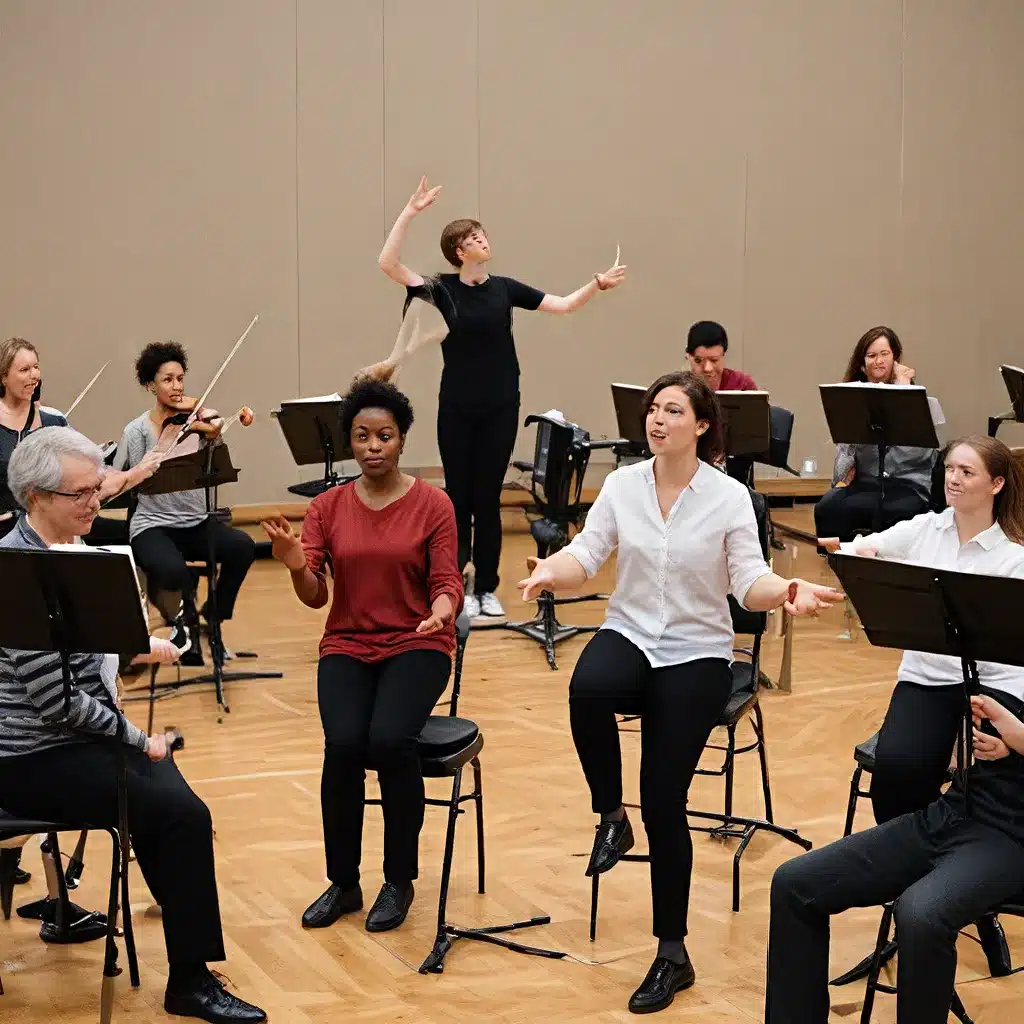
Embracing the Ensemble: A Conductor’s Journey
As a passionate conductor, I’ve always believed that the heart of any great musical performance lies in the collaborative spirit that binds an ensemble together. It’s not just about the notes on the page or the baton in my hand – it’s about fostering an environment where every individual voice is heard, respected, and empowered to contribute to the whole.
You see, I’ve had the privilege of working with choirs and orchestras of all shapes and sizes, from the pristine halls of the Musical Theater Center to the vibrant streets of New York City. And in every rehearsal, I’ve witnessed the transformative power of inclusive leadership. It’s not always an easy path, but the rewards are truly remarkable.
Cultivating Belonging: The Conductor’s Toolkit
So, what does it mean to be a collaborative conductor? Well, it’s all about fostering a sense of belonging within your ensemble – creating a space where every member feels seen, heard, and valued. It’s about breaking down the barriers of hierarchy and empowering your musicians to take an active role in the creative process.
One of the key techniques I’ve found to be particularly effective is the use of interactive conducting gestures. Instead of simply waving a baton and expecting the ensemble to follow, I encourage my musicians to respond to my cues with their own interpretations and expressions. It’s a delicate dance, to be sure, but the result is a living, breathing performance that truly reflects the collective spirit of the group.
Another powerful tool in my collaborative conductor’s toolkit is the art of massed choir rehearsals. By bringing together multiple choirs for a shared experience, I’ve witnessed the most incredible moments of connection and community. It’s not just about blending voices – it’s about forging bonds, sharing stories, and discovering the common threads that unite us all.
Embracing Diversity: The Path to Inclusive Excellence
Of course, fostering a truly inclusive rehearsal environment goes beyond just technical skills. It requires a deep-seated commitment to celebrating the unique perspectives and lived experiences of every individual in the ensemble.
I’ll never forget the time I had the opportunity to work with the Voices of Unity Youth Choir. These young singers came from all walks of life, each with their own rich cultural heritage and personal narrative. And as we delved into the music, I saw them blossom, sharing their stories and finding common ground in the most unexpected ways.
It was a powerful reminder that true artistic excellence isn’t about conformity – it’s about embracing the diversity that makes us human. By encouraging my ensemble members to bring their authentic selves to the table, I’ve witnessed the most incredible transformations, both musically and personally.
Collaboration in Action: Lessons from the Field
Of course, putting these collaborative techniques into practice isn’t always easy. There have been plenty of challenges along the way, from navigating individual personalities to managing the logistics of large-scale productions. But through it all, I’ve learned that the key to success lies in a willingness to be flexible, to listen, and to embrace the unexpected.
Take, for example, my experience working with the In Harmony Enhanced Residency & Concert Performance in New York City. As the principal conductor and composer-in-residence, I had the honor of collaborating with choirs from across the country, each with their own unique strengths and perspectives.
It was a whirlwind of activity, with massed choir rehearsals, city adventures, and a breathtaking final performance. But what struck me most was the way the singers came together, sharing their stories, supporting one another, and finding the common ground that united them. It was a true testament to the power of collaborative music-making.
Embracing the Future: A Vision for Inclusive Excellence
As I look to the future, I’m filled with a renewed sense of purpose and excitement. The world of music education and performance is evolving, and I believe that the collaborative conductor has a vital role to play in shaping this new landscape.
Imagine a future where every rehearsal is a space of belonging, where every voice is celebrated, and where the transformative power of music-making is harnessed to build bridges and forge connections. It’s a bold vision, to be sure, but one that I’m deeply committed to bringing to life.
Because at the end of the day, the magic of music isn’t just about the notes on the page or the accolades on the wall. It’s about the human connections we forge, the stories we share, and the communities we build. And as a collaborative conductor, I’m honored to be a part of that journey, every step of the way.
So let’s embrace the ensemble, cultivate belonging, and celebrate the diversity that makes us stronger. Together, we can redefine the role of the conductor and create a future where inclusive excellence is the norm, not the exception.

